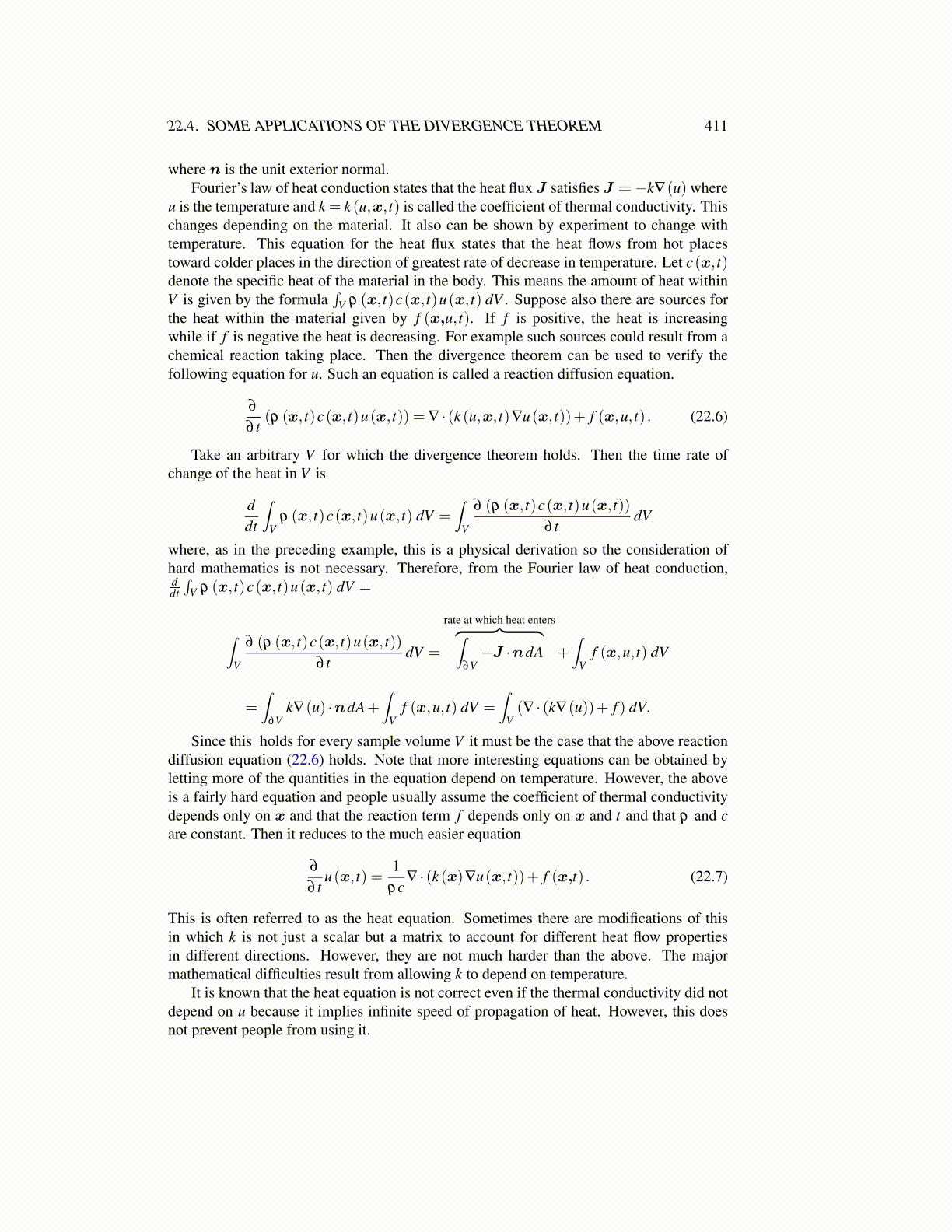
22.4. SOME APPLICATIONS OF THE DIVERGENCE THEOREM 411
where n is the unit exterior normal.Fourier’s law of heat conduction states that the heat flux J satisfies J =−k∇(u) where
u is the temperature and k = k (u,x, t) is called the coefficient of thermal conductivity. Thischanges depending on the material. It also can be shown by experiment to change withtemperature. This equation for the heat flux states that the heat flows from hot placestoward colder places in the direction of greatest rate of decrease in temperature. Let c(x, t)denote the specific heat of the material in the body. This means the amount of heat withinV is given by the formula
∫V ρ (x, t)c(x, t)u(x, t) dV . Suppose also there are sources for
the heat within the material given by f (x,u, t). If f is positive, the heat is increasingwhile if f is negative the heat is decreasing. For example such sources could result from achemical reaction taking place. Then the divergence theorem can be used to verify thefollowing equation for u. Such an equation is called a reaction diffusion equation.
∂
∂ t(ρ (x, t)c(x, t)u(x, t)) = ∇ · (k (u,x, t)∇u(x, t))+ f (x,u, t) . (22.6)
Take an arbitrary V for which the divergence theorem holds. Then the time rate ofchange of the heat in V is
ddt
∫V
ρ (x, t)c(x, t)u(x, t) dV =∫
V
∂ (ρ (x, t)c(x, t)u(x, t))∂ t
dV
where, as in the preceding example, this is a physical derivation so the consideration ofhard mathematics is not necessary. Therefore, from the Fourier law of heat conduction,ddt∫
V ρ (x, t)c(x, t)u(x, t) dV =
∫V
∂ (ρ (x, t)c(x, t)u(x, t))∂ t
dV =
rate at which heat enters︷ ︸︸ ︷∫∂V−J ·ndA +
∫V
f (x,u, t) dV
=∫
∂Vk∇(u) ·ndA+
∫V
f (x,u, t) dV =∫
V(∇ · (k∇(u))+ f ) dV.
Since this holds for every sample volume V it must be the case that the above reactiondiffusion equation (22.6) holds. Note that more interesting equations can be obtained byletting more of the quantities in the equation depend on temperature. However, the aboveis a fairly hard equation and people usually assume the coefficient of thermal conductivitydepends only on x and that the reaction term f depends only on x and t and that ρ and care constant. Then it reduces to the much easier equation
∂
∂ tu(x, t) =
1ρc
∇ · (k (x)∇u(x, t))+ f (x,t) . (22.7)
This is often referred to as the heat equation. Sometimes there are modifications of thisin which k is not just a scalar but a matrix to account for different heat flow propertiesin different directions. However, they are not much harder than the above. The majormathematical difficulties result from allowing k to depend on temperature.
It is known that the heat equation is not correct even if the thermal conductivity did notdepend on u because it implies infinite speed of propagation of heat. However, this doesnot prevent people from using it.